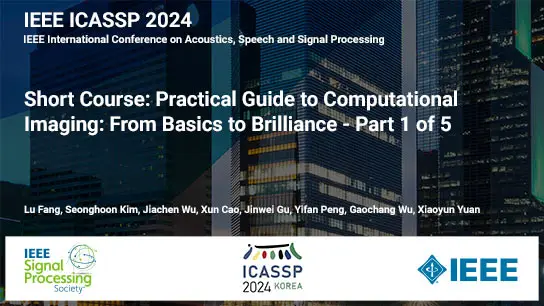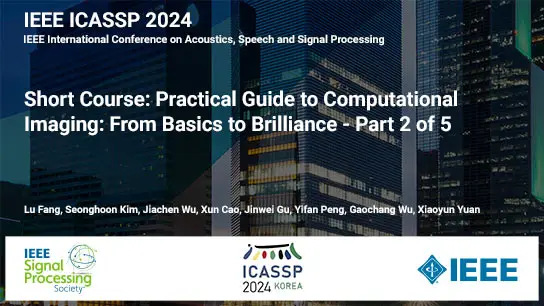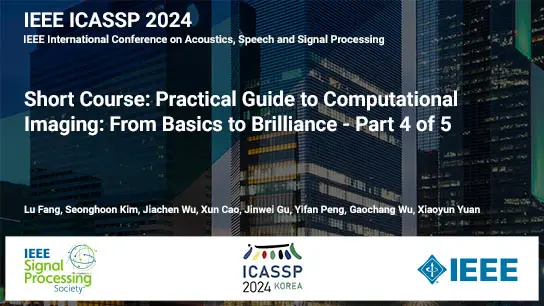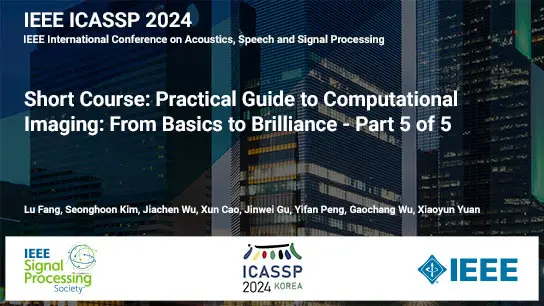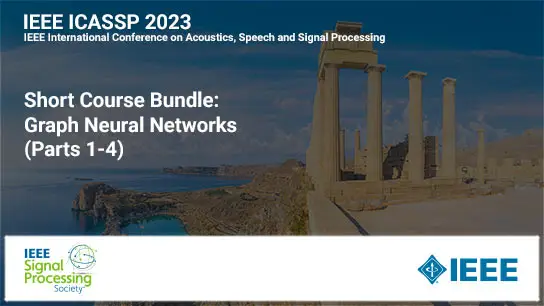Short Course Bundle: ICASSP 2024 COURSE 2: Practical Guide to Computational Imaging: From Basics to Brilliance - Parts 1-5, April 2024
Lu Fang, Seonghoon Kim, Jiachen Wu, Xun Cao, Jinwei Gu, Yifan Peng, Gaochang Wu, Xiaoyun Yuan
-
Members: $65.00SPS
IEEE Members: $85.00
Non-members: $100.00
About this Bundle
Short Course Bundle: ICASSP 2024 COURSE 2: Practical Guide to Computational Imaging: From Basics to Brilliance - Parts 1-5, April 2024
Computational imaging stands at the intersection of mathematics, computer science, and physics, seamlessly blending these disciplines into an innovative field. Its primary mission is to mask the invisible visible, encompassing tasks such as photograph a black hole, image around corners, seeing through fogs and so on. These extraordinary capabilities are harnessed through the joint designing of optical hardware and computational algorithms, birthing novel imaging systems. By conscientiously designing both the hardware and software aspects, computational imaging shatters the boundaries of traditional imaging, transcending challenges like dynamic range, spatial resolution, and depth of field. In contemporary times, computational imaging technology finds widespread utility in both industry and science. Notably, it assumes a prominent role in consumer smartphones, where industry giants such as Apple and Google have established dedicated teams to pioneer computational photography. These ubiquitous pocket-sized cameras necessitate algorithmic innovations due to hardware constraints—limited by their slim form factors and cost considerations, specialized lenses and extravagant designs remain impractical. Beyond smartphone photography, computational imaging technology extends its influence to autonomous vehicles, elevating their perceptual capabilities to superhuman levels. An autonomous vehicle, commonly referred to as a self-driving car, possesses the capability to actively perceive its surroundings and navigate safely even when human intervention is minimal or entirely absent. It is not a requirement that camera sensors on these cars should mimic the human eye: they can surpass it. Moreover, computational imaging technology has made significant contributions to biomedical and medical imaging. This field, focused on visualizing and comprehending biological structures and processes across scales, from the molecular to the organismal, has benefited immensely. Researchers and clinicians now delve deeper into the complexities of biology, leading to groundbreaking advancements in diagnostics, treatment development, and an enhanced understanding of life sciences. Contributions to the field of computational imaging have emanated from a diverse array of academic disciplines, encompassing signal processing, optics, machine learning, computer vision, computer graphics, applied mathematics, and others. The strides achieved in computational imaging are intrinsically tied to the progress made in these respective fields. Notably, computational imaging stands as not merely a shared interest among these heterogeneous communities but rather as an indispensable tool to confront contemporary scientific challenges.
16 Aug 2024
